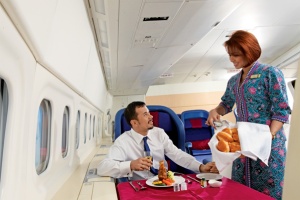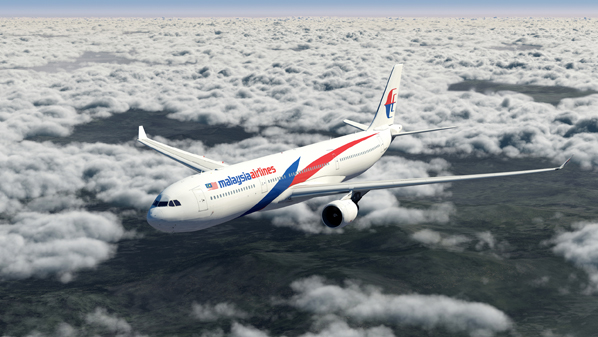Breaking Travel News Interview: Malaysia Airlines chief executive Ahmad Jauhari Yahya

Riding on the momentum of being named Asia’s Leading Airline and Asia’s Leading Airline Lounge by the World Travel Awards, Malaysia Airlines has a number of exciting initiatives planned for 2012.
The carrier will target Asia’s premium travellers when it launches its brand new short-haul brand that will fly an entirely new Boeing 737-800 fleet. The airline will also take delivery of 23 new aircraft over the next 12 months, five of which will be its first A380 aircraft.
In addition, Malaysia also plans to increase frequency to Jakarta, Medan, Bangkok, Phnom Penh, Beijing, Taipei and Los Angeles, as of March 25th 2012.
Breaking Travel News caught up with Ahmad Jauhari Yahya, Group Chief Executive Officer, Malaysia Airlines, to find out more about these developments and to why he anticipates ASEAN passenger demand to double by 2020.
BTN: Can you comment on the significance of being named Asia’s Leading Airline and Asia’s Leading Airline Lounge by the World Travel Awards in 2011?
AJY: Malaysia Airlines is proud and honoured to have been selected by such an esteemed group of industry peers to be named as the World’s Leading Airline to Asia 2011, as well as recognition at the regional-level awards as Asia’s Leading Airline 2011 and for our flagship lounge at the Kuala Lumpur International Airport as Asia’s Leading Airline Lounge 2011.
These wins are testimony of our efforts to deliver a premium service offering and are a fitting tribute to the dedicated and relentless efforts of the staff of Malaysia Airlines.
Malaysia Airlines remains committed to continuously invest in upgrading our premium service offerings, both on the ground and in-flight for our guests.
We are confident that our efforts will continue to be recognised in the years ahead.
BTN: To what do you attribute this success? What are the key factors differentiating you from other carriers in the region?
AJY: The credit for this success largely goes to the dedication of our employees’ for their unwavering commitment to deliver Malaysian Hospitality at its best.
This must surely be one of the main factors that differentiates Malaysia Airlines from others - the natural hospitable way we serve our customers which we call the unique Malaysian Hospitality accorded to all guests to create exemplary customer experience at every touch-point.
This “customer first” approach is what makes all the difference.
BTN: In December you unveiled a new business plan to return Malaysia Airlines to the black by 2013, which is focused on shrinking the Malaysia network and focusing on costs while winning back customers. What will be priority destinations on the Malaysia Airlines route network and where will you cut back?
AJY: Our extensive network is the heart of the company and, while we want to serve our customers as well as we can, we recognise that in meeting the growing challenges of the aviation sector today, we will need to re-examine the viability of all the routes we were flying to.
This is to ensure the Company’s long-term sustainability.
As highlighted in our Business Plan, we believe the Company needs to consolidate at this time - to shrink now, in order to be able to grow later.
Based on our analysis, to achieve this in the short term we will need to focus mainly on increasing frequencies within our Asian network this year.
Several routes between Malaysia will see increased frequency effective 25 March 2012. These are Jakarta, Medan, Bangkok, Phnom Penh, Beijing, Taipei and Los Angeles.
In others, as part of our strategic consolidation process, we are suspending several routes for the time being between Kuala Lumpur and Surabaya, Karachi, Dubai, Dammam, Johannesburg, Cape Town, Buenos Aires, Rome, Perth, Osaka, Seoul and Haneda (Tokyo).
These routes account for almost 12 per cent of our passenger capacity and it is necessary for us as part of our recovery efforts.
Going forward, our network will continue focus on key ASEAN routes with significant premium passenger traffic, and where we can win in terms of competitive positioning and regional advantage.
.jpg)
BTN: What is your plan to win back customers and what strengths will you leverage to do this?
AJY: Our customers are our top priority. In addition to the phased roll-out of our new product, we shall strive to improve customer experience at every operational touch point, be it pre-flight, in-flight and post-flight.
Malaysia Airlines will deliver on its brand promise consistently, across all touch points, channels, national borders and at all times.
We will take delivery of 23 aircraft in 2012, each with state-of-the-art passenger amenities.
As we introduce these products, we will reinvigorate our sales and marketing functions to win back the hard-earned loyalty of customers, and reintroduce them of the superior value of our enhanced services.
Building on our new fleet, we are refreshing our approach to branding, distribution and customer loyalty.
We are overhauling our commercial approach and revenue management systems to gain much larger share of corporate travel, drive front-end cabin revenue and fully leverage our oneworld membership to generate traffic.
Going forward, we will prioritise growth in regions where we can offer customers truly leading connectivity and leverage on our defendable leadership positions for the consumers’ benefits.
BTN: The market in Asia has shown amazing resilience during uncertain economic times. What kind of opportunities are there? In what ways will you leverage these?
AJY: We anticipate a growth in demand in Asia particular in the ASEAN region and we expect other carriers will also be gearing towards capturing this growth. At the same time ASEAN countries are targeting to have open skies in 2015.
Historically, the excess capacity and deregulation leads to market consolidation. Therefore, it is important that we differentiate ourselves against other carriers in this region and become the preferred premium carrier.
In the first half of 2012, we will launch our new short-haul brand, flying an entirely new Boeing 737-800 fleet that is specifically targeted to meet the needs of Asia’s premium travellers.
This new fleet will not only provide new premium product offerings, it will also provide connections during time periods convenient to the customers’ schedules.

BTN: How will your customers and oneworld passengers benefit when you join oneworld later this year?
AJY: By the end of 2012, we will be the newest member of the oneworld alliance. We are excited to join this extensive global network and look forward to increasing traffic via our combined networks and infrastructure.
The oneworld membership will allow our valued customers to enjoy easier transfers, code-shares, and greater route access of our alliance partners, as well as maximising the benefits of greater flexibility on usage of miles points, access to world class lounges and other rewards.
To augment our alliance membership, we also intend to enter into material partnerships with other major airlines to link our respective geographic strengths into a unified international presence.
BTN: What are your expectations for the delivery of your first six A380 aircraft in the end quarter of this year? What will the new aircraft add to your services?
AJY: This year, we will take delivery of five of the six A380 aircraft ordered.
The first aircraft will be received by the second quarter of this year.
The A380 provides the lowest fuel burn per seat enabling the airline to maximise its profitability and achieve sustainable growth in the longer term.
The arrival of the A380 comes at a time when Malaysia Airlines has had to adopt a relentless cost focus in our operations.
In fact, part of our poor cost position has been due to the age of many of our aircraft.
With a new fleet of aircraft, we will be able to better manage costs. The A380 will enable us to quickly capitalise on the tremendous savings offered through its improved fuel efficiency.
More importantly, the A380 will also be a blueprint for us in reintroducing ourselves as the premium carrier and it will be then expanded to the rest of our fleets. We have more exciting plans for the A380 and will reveal them at an appropriate time.
At this point what we can confirm is that the inaugural flight of Malaysia Airlines’ A380 will be on our Kuala Lumpur-London route effective July 1st 2012.
BTN: How are you coping with financial and regulatory pressures on the airline industry, in particular the Air Passenger Duty tax implemented in the UK and the new Emissions Trading Scheme in Europe?
AJY: Malaysia Airlines has always complied with regulatory requirements in all markets. Where possible, we absorb charges directly related to operational costs.
As with the views of many other airlines, we are monitoring the situation with respect to the imposition of the proposed ETS and shall advise of developments as these become available.
With respect to levies required of passengers, we will provide advanced alerts to customers and shall strive to ensure that the collection of any new levy causes our customers the least inconvenience possible.
BTN: What are your key predictions for the aviation industry in Asia for 2012? What new trends should we be looking out for?
AJY: The demand outlook for the Asian aviation sector is strong, fuelled by a burgeoning middle class and increased global and intra-regional trade.
Across Asia, there is huge growth in disposable income, ramped-up access to credit cards and the Internet, coupled with increased cross-border trade.
South-east Asia, in particular, with its combined population of over 500 million, myriad islands and under-developed road and rail infrastructure, is well-placed for aviation growth.
Indeed, we expect ASEAN passenger demand to double by 2020. This is rightfully an exciting market for all participants in the aviation industry.
Based on forecasts of GDP growth, trade flows and other commercial/business factors, we anticipate a doubling of demand over the coming decade.
This presents an inviting opportunity to all airlines in the region, and we are not alone in making sizeable aircraft orders to fill the demand.
At the same time, aviation markets in the region are being liberalised, with most ASEAN countries targeting completely ‘open skies’ by 2015. This will allow carriers from any country to serve passengers in more overseas markets.
The combination of overcapacity and deregulation has led to dramatic consolidation the world over. In the US and Europe, the top three airlines account for 40 – 60 per cent of the market.
In Asia, they account for only 20 per cent. Consolidation will inevitably come to Asia as well.
Success in such challenging environments depends on the creation of a differentiated approach. This can be earned through building a leading cost position or by creating a unique value proposition to customers. We will do both.
Perhaps more so than in other markets, we are also witnessing a rapid segmentation of the regional market, with carriers differentiating themselves along two dimensions: ‘low cost’ versus ‘full service,’ and ‘short haul’ versus ‘long haul.’
Increasingly, airline owners are looking to place their chips in multiple segments.
For Malaysia Airlines, we are charting our future strongly in the full service, long-haul segment, with plans for extended participation in the full service, short-haul segment as well.

